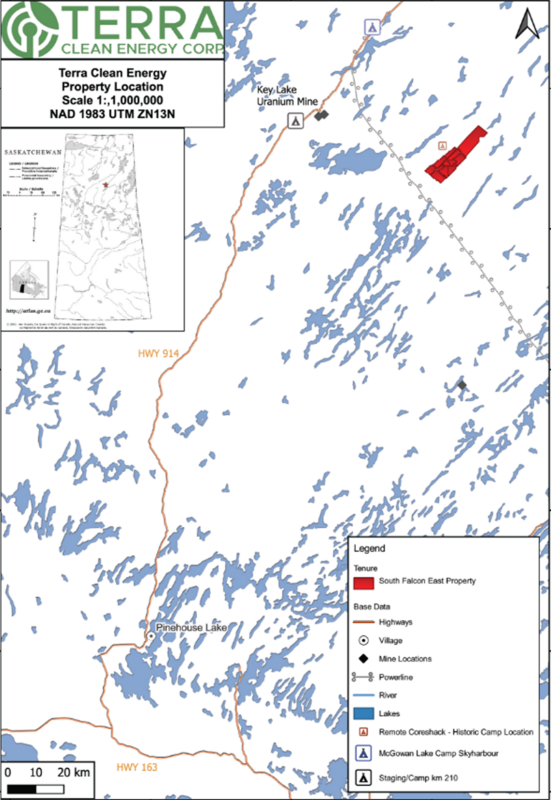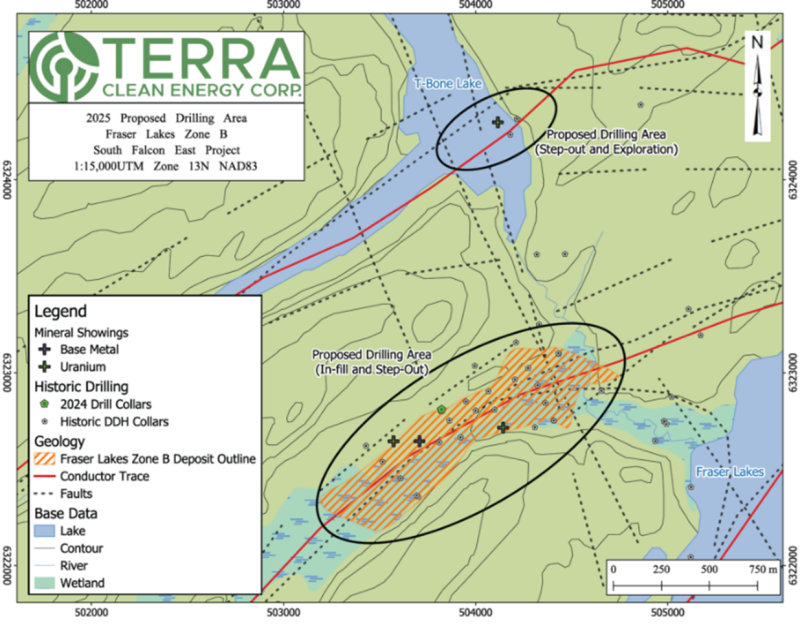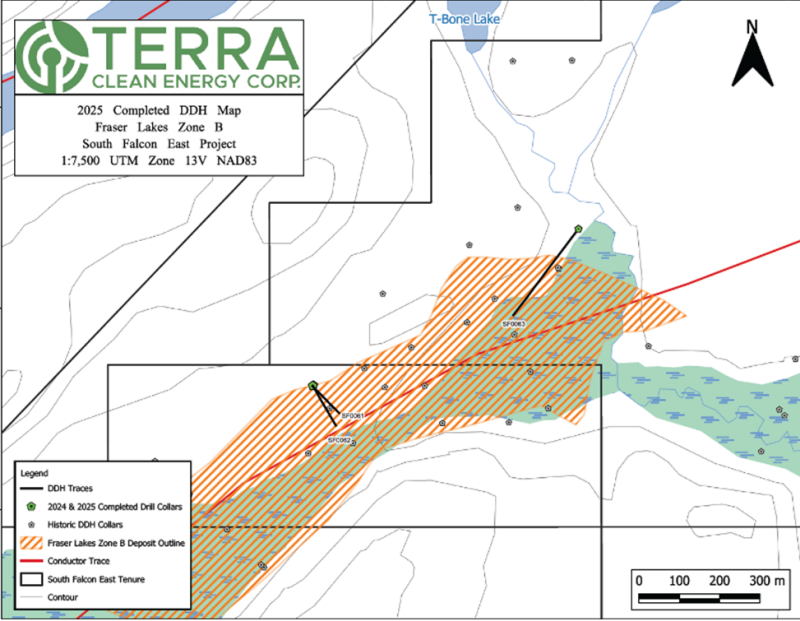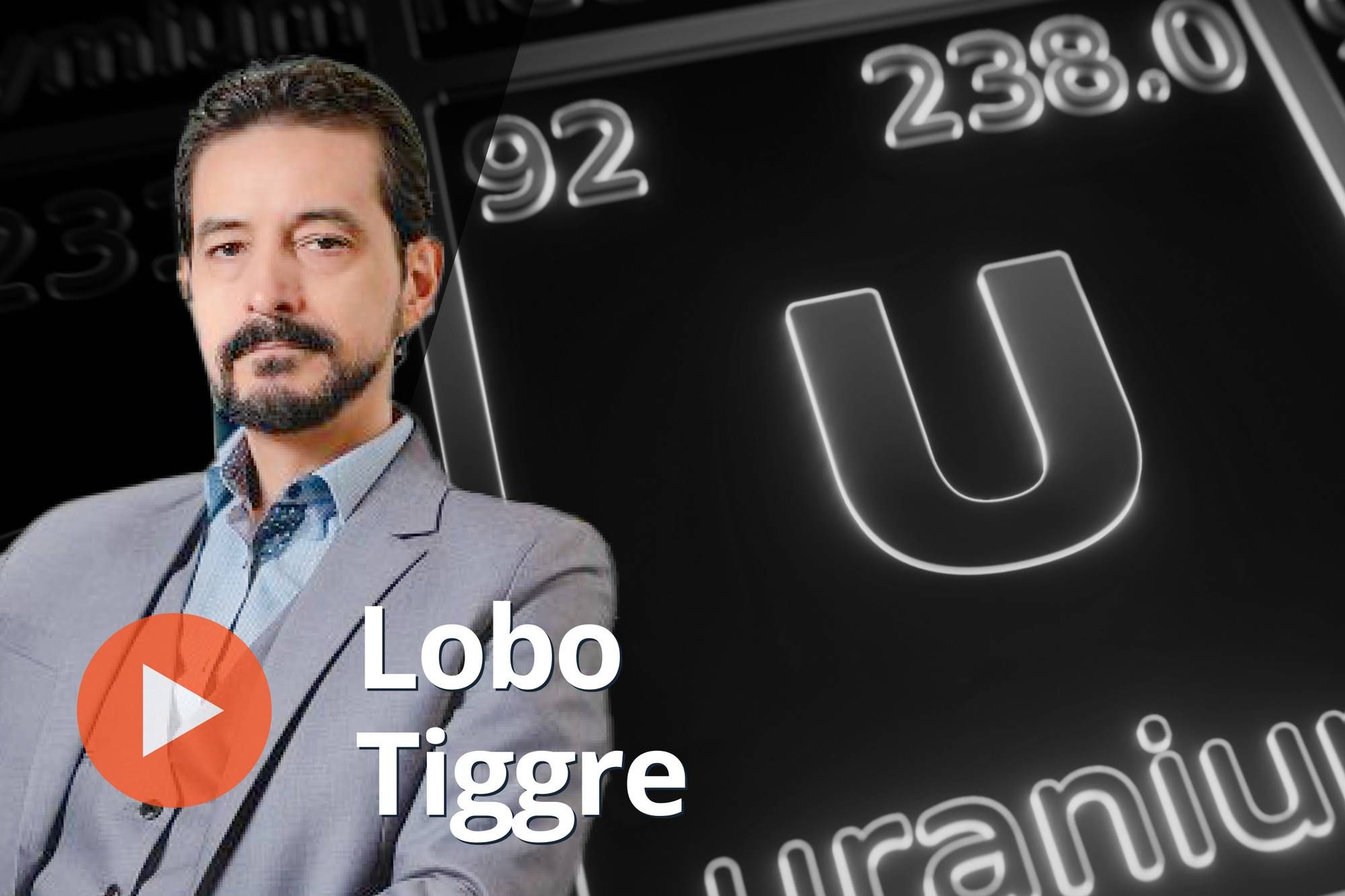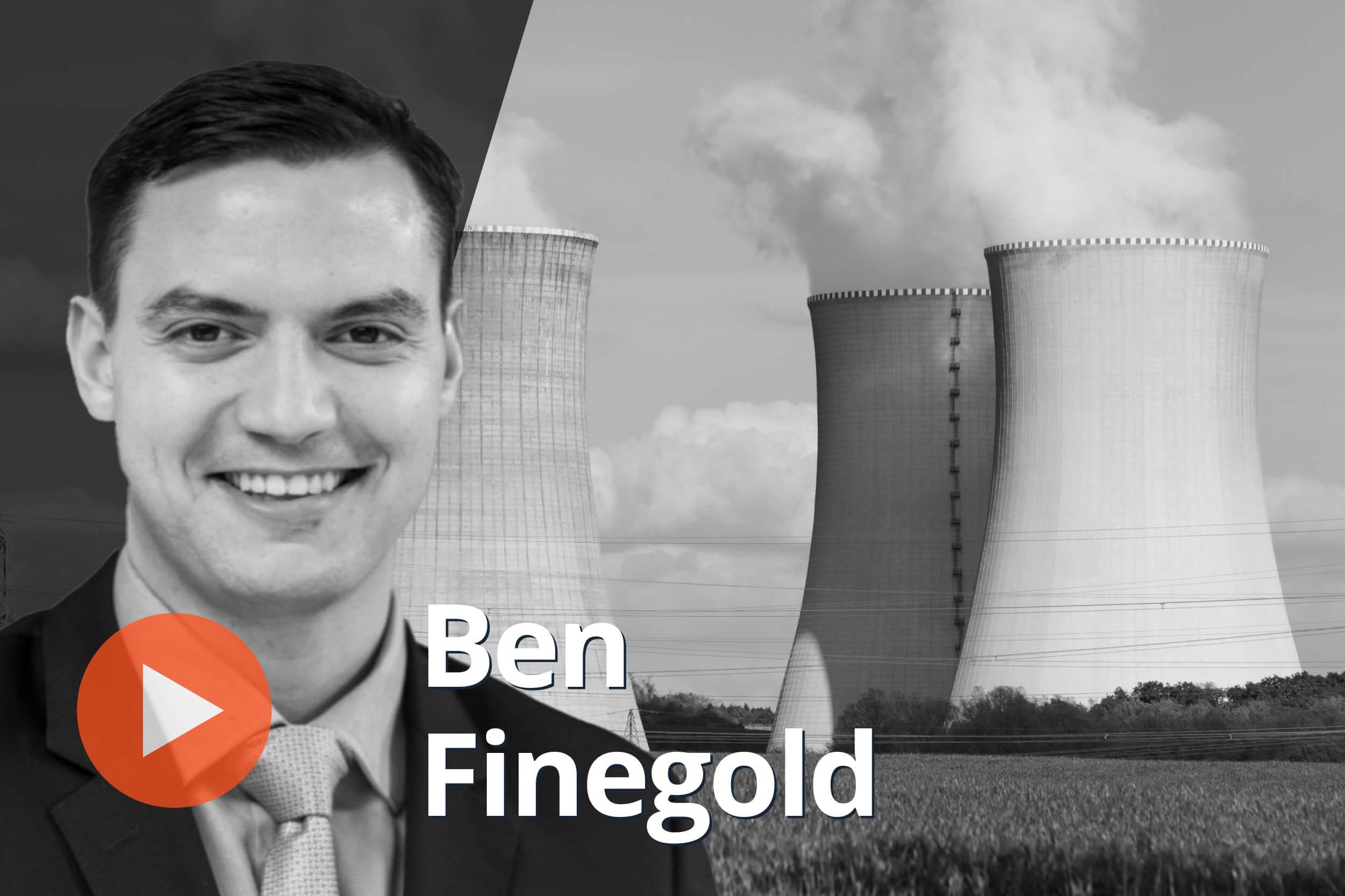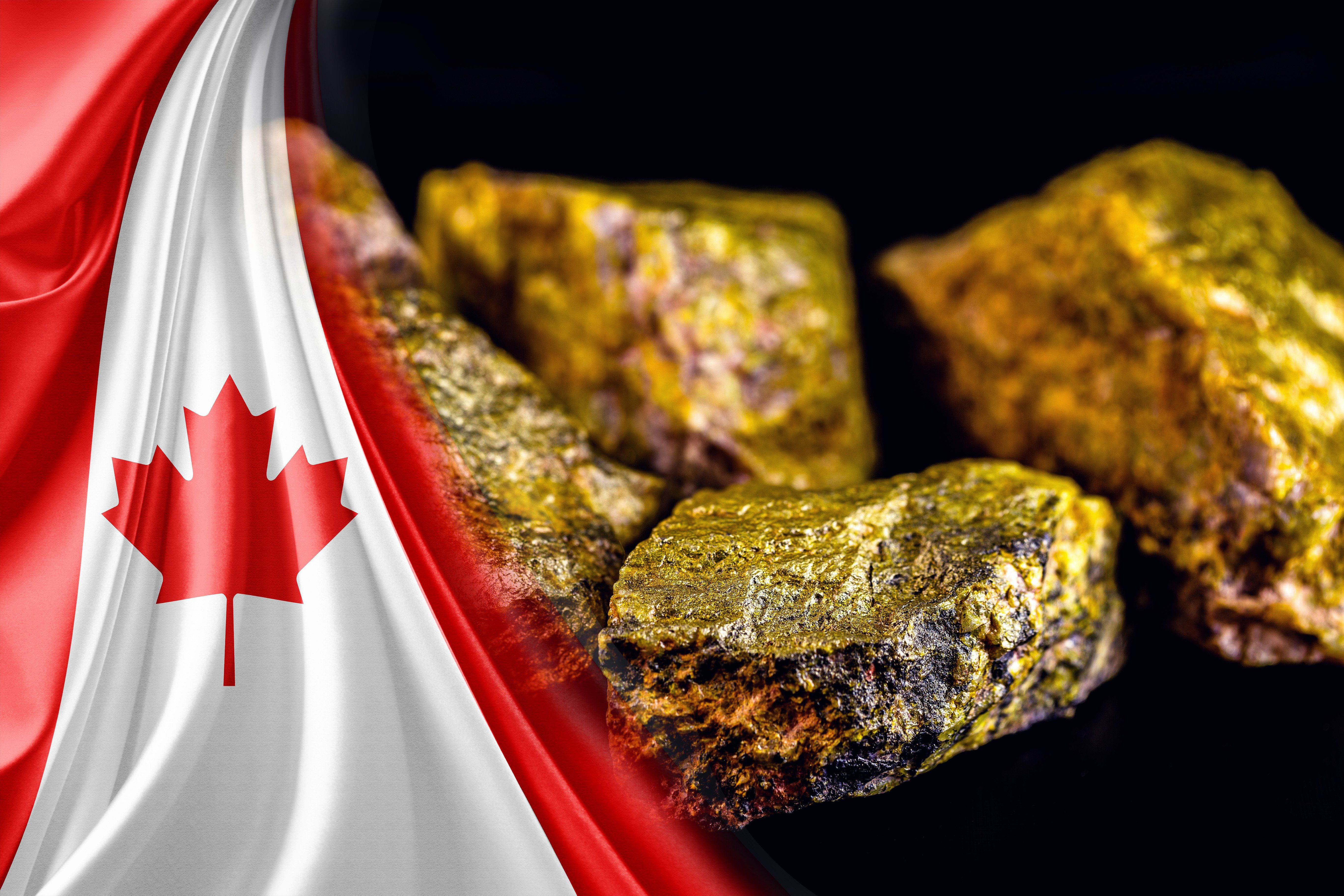
March 10, 2025
TERRA CLEAN ENERGY CORP. (“Terra” or the “Company”) (CSE: TCEC, OTCQB: TCEFF, FSE: 9O0), is pleased to announce the completion of the first three drill holes at the South Falcon East Uranium Project (the “Property”) which hosts the Fraser Lakes B Uranium Deposit. Drilling will continue throughout March and is expected to complete over 2000 meters (m) of drilling.
The South Falcon East Project lies 18 km outside the edge of the Athabasca Basin, approximately 50 km east of the Key Lake uranium mill and former mine (Figure 1). The Company entered into an option agreement with Skyharbour Resources Ltd. (“Skyharbour”) in October of 2022 whereby the company can earn up to a 75% interest in the Property.
The Company is currently conducting a 2000-2200 m helicopter supported drill program at the Property. Three diamond drill holes have been completed on the Fraser Lakes B Uranium Deposit, for a total of 802 m. A fourth hole in progress. (Figure 3)
“We are extremely encouraged by the results of the first three drill holes as we continue to see minerlization in each of the first three holes as well as what we believe to be an expansion of the deposit to the North. As stated below, Hole SF063 returned a continuous mineralized zone of pegmatities from 173 meters to 224 meters with some decent grades.” Based on the initial results from Hole SF063 we have decided to reorganize the remaining meters of this program to focus on further defining this new area of interest and chasing clay alteration not yet seen on the property to date, with hopes of finding a high grade unconformity uranium deposit.” said Greg Cameron CEO of the Company.
Hole SF063 was planned to examine an interpreted cross fault offsetting the mineralization and geology on the east end of the Fraser Lakes B Uranium Deposit. This hole was drilled to a depth of 393 meters and intersected multiple structures and a 51 m wide interval of mineralized granitic pegmatites and zones within altered and graphitic pelitic gneiss. Highlights include:
- 0.03% eU over 12.0 m from 173.55 to 185.55 m,
including 0.06% eU3O8 over 0.7 m from 180.35 to 181.05 m
- 0.03% eU over 3.0 m from 213.65 to 216.65 m,
including 0.07% eU3O8 over 0.5 m from 215.95 to 216.45 m
The first structure intersected from 18 m to 47.5m contained zones of intense clay alteration typically found in relation to unconformity uranium deposits. The presence of this alteration is a good indication that hydrothermal fluids suitable for deposition of higher-grade uranium deposits moved through the rocks. The second structure from 306 to 315 m is a brecciated pelitic gneiss situated between two intervals of Archean gneiss. This structure is interpreted to be responsible for the geological offset being targeted. This will assist in updating the target model in this area. The intersections of a clay altered structure and a thick sequence of mineralized pegmatites and pelitic gneiss have expanded the mineralization and improved the prospectivity on the east end of the Fraser Lakes B Uranium Deposit.
”The results from the drilling so far are very encouraging,” commented Trevor Perkins, Vice President of Exploration for Terra Clean Energy Corp. “The first two holes have shown that the deposit is still open down dip to the north and northwest. Hole SF0063 has shown that there is significant potential for upgrading the deposit on the east end. We are excited to see where this can lead”, continued Mr. Perkins.
Drilling is continuing with one hole in progress in the T-Bone lake area to examine the conductive package and alteration intersected in the area in historical drilling. Pad preparation is underway to return to the area around SF0063 and follow up on the clay alteration and pegmatites. Efforts will be made to follow the alteration and pegmatites to where they intersect, as this should be an area of fluid pooling and upgrading of mineralization within the deposit.
Hole SF061 was planned to test for a down dip extension of mineralization intersected in hole FP-15-05 and was drilled to a depth of 209 m. Drilling intersected a 35 m interval containing multiple mineralized granitic pegmatites and zones within altered and graphitic pelitic gneiss. The most notable zone returned an equivalent grade of 0.02% eU3O8 over 2.2 m from 150.25 to 152.45 m, including 0.05% eU3O8 over 0.6 m from 151.65 to 152.25 m.
Historical diamond drill hole FP-15-05 was drilled by Skyharbour in 2015 and returned multiple zones of mineralization over a 14m interval, including 6m of .10% U308 (including a 2m of 0.165% U3O8 (from 135m) and 2.5m of 0.172% U3O8 (from 145m).
Hole SF062 was planned to test for an along strike extension of mineralization intersected in holes FP-15-05 and SF0061, and was drilled to a depth of 200 m. Drilling intersected a 21 m interval containing multiple mineralized granitic pegmatites and zones within altered and graphitic pelitic gneiss. The most notable zone returned an equivalent grade of 0.03% eU3O8 over 2.2 m from 141.75 to 144.15 m, including 0.05% eU3O8 over 0.4 m from 143.15 to 143.55 m.
While both of these holes extended the mineralization down dip and along strike to the north and northwest, they did not intersect the higher grades encountered in hole FP-15-05. This is due to the potential variability within the pegmatite swarm. As long as the mineralized pegmatites are present, higher grades will be encountered within the overall mineralized zone.
Figure 1: South Falcon East Uranium Project Location – Eastern Athabasca Basin, Saskatchewan, Canada
Figure 2: 2025 Drill Target areas at the South Falcon East Uranium Project
Figure 3: 2025 - Completed drill holes at South Falcon East Uranium Project
Samples of the mineralized intervals within the drill core have been collected and shipped for analysis at the Geoanalytical Laboratory at the Saskatchewan Research Council in Saskatoon, Saskatchewan. The Company will provide more detailed results once geochemical analysis of the collected core samples is completed, reviewed and confirmed.
QA/QC, Radiometric Equivalent Grades and Spectrometer Readings:
All drill intervals above are downhole length and sampling procedures and QA/QC protocols for geochemical results as well as a description of downhole gamma probe grade calculations and protocols are below. All drill core samples are shipped to the Saskatchewan Research Council Geoanalytical Laboratories (“SRC”) in Saskatoon, Saskatchewan under the care of Terra personnel for preparation, processing, and multi-element analysis by ICP-MS and ICP-OES using total (HF:NHO3:HClO4) and partial digestion (HNO3:HCl), boron by fusion, and U3O8 wt% assay by ICP-OES using higher grade standards. Assay samples are chosen based on visual inspection, downhole probing radiometric equivalent uranium grades and scintillometer (Radiation Solutions RS-125) peaks. Assay sample intervals comprise 0.5 to 1.0 metre continuous half-core split samples over the mineralized interval. These samples may also be selected for density determination using the lost wax method. With all assay samples, one half of the split sample is retained and the other sent to the SRC for analysis. The SRC is an ISO/IEC 17025/2005 and Standards Council of Canada certified analytical laboratory. Blanks, standard reference materials, and repeats are inserted into the sample stream at regular intervals by Terra and the SRC in accordance with Terra’s quality assurance/quality control (QA/QC) procedures. Geochemical assay data are subject to verification procedures by qualified persons employed by Terra prior to disclosure.
During active exploration programs drillholes are radiometrically logged using calibrated downhole Mount Sopris 4OTGU or 2GHF probes of varying sensitivities which collect continuous readings along the length of the drillhole. Preliminary radiometric equivalent uranium grades (“eU3O8”) are then calculated from the downhole radiometric results. The probe is calibrated using an algorithm calculated from the calibration of the probe at the Saskatchewan Research Council facility in Saskatoon and from the comparison of probe results against geochemical analyses. In the case where core recovery within a mineralized intersection is poor or non-existent, radiometric grades are considered to be more representative of the mineralized intersection and may be reported in the place of assay grades. Radiometric equivalent probe results are subject to verification procedures by qualified persons employed by Terra prior to disclosure.
About Terra Clean Energy Corp.
Terra Clean Energy (formerly Tisdale Clean Energy Corp) is a Canadian-based uranium exploration and development company. The Company is currently developing the South Falcon East uranium project, which holds a 6.96M pound inferred uranium resource within the Fraser Lakes B Uranium Deposit, located in the Athabasca Basin region, Saskatchewan, Canada.
ON BEHALF OF THE BOARD OF TERRA CLEAN ENERGY CORP.
“Greg Cameron”
Greg Cameron, CEO
Qualified Person
The technical information in this news release has been prepared in accordance with the Canadian regulatory requirements set out in National Instrument 43-101 and reviewed on behalf of the company by C. Trevor Perkins, P.Geo., the Company’s Vice President, Exploration, and a Qualified Person as defined by National Instrument 43-101.
*The historical resource is described in the Technical Report on the South Falcon East Property, filed on sedarplus.ca on February 9, 2023. The Company is not treating the resource as current and has not completed sufficient work to classify the resource as a current mineral resource. While the Company is not treating the historical resource as current, it does believe the work conducted is reliable and the information may be of assistance to readers.
Forward-Looking Information
This news release contains forward-looking information which is not comprised of historical facts. Forward-looking information is characterized by words such as “plan”, “expect”, “project”, “intend”, “believe”, “anticipate”, “estimate” and other similar words, or statements that certain events or conditions “may” or “will” occur. Forward-looking information involves risks, uncertainties and other factors that could cause actual events, results, and opportunities to differ materially from those expressed or implied by such forward-looking information, including statements regarding the potential development of mineral resources and mineral reserves which may or may not occur. Factors that could cause actual results to differ materially from such forward-looking information include, but are not limited to, changes in the state of equity and debt markets, fluctuations in commodity prices, delays in obtaining required regulatory or governmental approvals, and general economic and political conditions. Forward-looking information in this news release is based on the opinions and assumptions of management considered reasonable as of the date hereof, including that all necessary approvals, including governmental and regulatory approvals will be received as and when expected. Although the Company believes that the assumptions and factors used in preparing the forward-looking information in this news release are reasonable, undue reliance should not be placed on such information. The Company disclaims any intention or obligation to update or revise any forward-looking information, whether because of new information, future events or otherwise, other than as required by applicable laws. For more information on the risks, uncertainties and assumptions that could cause our actual results to differ from current expectations, please refer to the Company’s public filings available under the Company’s profile at www.sedarplus.ca.
Neither the CSE nor its Regulation Services Provider (as that term is defined in the policies of the CSE) accepts responsibility for the adequacy or accuracy of this release.
For further information please contact:
Greg Cameron, CEO
Terra Clean Energy Corp
Suite 303, 750 West Pender Street
Vancouver, BC V6C 2T7

Sign up to get your FREE
Terra Clean Energy Investor Kit
and hear about exciting investment opportunities.
- Corporate info
- Insights
- Growth strategies
- Upcoming projects
GET YOUR FREE INVESTOR KIT
The Conversation (0)
30 June 2025
Terra Clean Energy
Advancing an expansive uranium landholding in the prolific Athabasca Basin
Advancing an expansive uranium landholding in the prolific Athabasca Basin Keep Reading...
18h
US Awards US$2.7 Billion to Expand Domestic Uranium Enrichment
The US government on Monday (January 5) allocated billions of dollars to revive domestic uranium enrichment, accelerating Washington's efforts to reduce reliance on foreign supply.The US Department of Energy (DOE) said it will award a total of US$2.7 billion over the next decade to three... Keep Reading...
23 December 2025
Lobo Tiggre: Supply Tight, Demand Strong, What's Next for the 2026 Uranium Market?
Lobo Tiggre, CEO of IndependentSpeculator.com, described uranium’s key role in providing baseload energy, a narrative that is only being heightened by added artificial intelligence data center and electric vehicle (EV) demand projections. “The use case is baseload power. There’s no substitution,... Keep Reading...
22 December 2025
Ben Finegold: Uranium in 2026 — Price Outlook, Plus Stocks, Supply and Demand
Ben Finegold, head of research at Ocean Wall, shares his 2026 outlook for uranium supply, demand and prices, emphasizing that the nuclear energy story remains strong. While 2025 brought little movement in the spot price, he believes the stage is set for higher numbers. Don't forget to follow us... Keep Reading...
19 December 2025
Denison, Skyharbour Finalize Saskatchewan Uranium Joint Venture Deal
Denison Mines (TSX:DML,NYSEAMERICAN:DNN) has closed a previously announced deal with Skyharbour Resources (TSXV:SYH,OTCQX:SYHBF) that repurposes a large block of uranium exploration ground surrounding Denison's flagship Wheeler River project in Northern Saskatchewan.The recent transaction... Keep Reading...
18 December 2025
5 Best-performing Canadian Uranium Stocks
The uranium market moved through 2025 with less drama than the previous year, but the quieter tone masked a sector where supply is still tightening beneath the surface. After 2024’s surge to two decade highs, U3O8 prices traded in a narrower range in 2025, slipping to a low of US$63.71 per pound... Keep Reading...
18 December 2025
Resource Expansion Drilling Confirms 3,000 metres of New Uranium Trends with Best Drill Hole of 1.4 GT over 7.6 metres
Resource expansion drilling of 50 holes completed at Lo Herma as planned yielding significant mineralised extensions over 3km to the north of proposed Mine Units 1 and 2. Drilling delivered AMU’s strongest intercept to date ahead of 2026 MRE and Scoping Study updates at AMU’s flagship Lo Herma ISR Uranium Project in Wyoming’s Powder River Basin.
American Uranium Limited (ASX:AMU, OTC:AMUIF) (American Uranium, AMU or the Company) is pleased to advise that 2025 resource expansion drilling at its Lo Herma ISR uranium project in Wyoming’s Powder River Basin (Lo Herma, the Project) has been completed according to plan with the drilling of 50... Keep Reading...
Latest News

Sign up to get your FREE
Terra Clean Energy Investor Kit
and hear about exciting investment opportunities.
- Corporate info
- Insights
- Growth strategies
- Upcoming projects
GET YOUR FREE INVESTOR KIT
Interactive Chart
Latest Press Releases
Related News
TOP STOCKS
American Battery4.030.24
Aion Therapeutic0.10-0.01
Cybin Corp2.140.00
